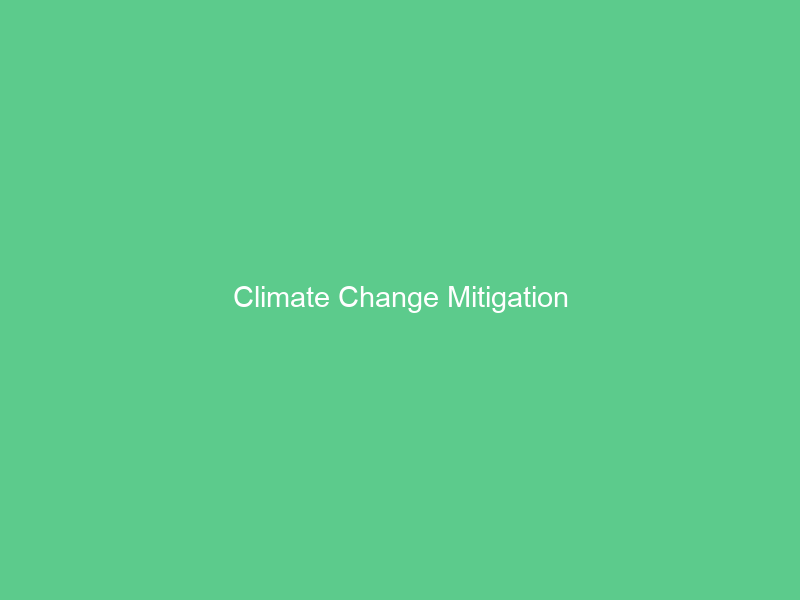Climate change mitigation refers to efforts aimed at decreasing emissions of heat-trapping greenhouse gases into the atmosphere by either decreasing sources or expanding “sinks”, thus mitigating its worst consequences. It is key to minimizing impacts caused by global climate change.
Cities can significantly lower emissions by improving public transportation systems, encouraging walking and cycling, supporting sustainable food consumption practices, and cutting waste. Strong policies and incentives make these changes more achievable and affordable.
Reducing Greenhouse Gas Emissions
At the core of mitigation is the aim to lower greenhouse gas (GHG) emissions or to increase carbon sinks that absorb them from the atmosphere. This involves shifting towards renewable energy sources, cutting energy waste, switching to regenerative agriculture practices and protecting and restoring forests or other natural carbon sinks as means to this end.
Reducing short-lived climate pollutants is one way to slow global warming while providing public health benefits like reduced air pollution levels. Furthermore, such measures could potentially save lives from heat-aggravated illnesses or vector-borne diseases as well as reduce risks related to water shortages, food insecurity and other climate change impacts.
Methane, nitrous oxide and fluorinated greenhouse gases can be reduced using various technologies available today. To assess their cost-effectiveness for reduction of these and other non-carbon dioxide greenhouse gas emissions, the Environmental Protection Agency and other agencies produce reports known as cumulative marginal abatement curves which researchers can use in their models; additionally these curves offer comparison with estimates of Social Cost of Carbon, or SC-CO2, used by federal agencies when proposing policies before going before Congress or President for approval.
Adapting to Changing Climates
Adaptation involves taking advantage of climate changes as opportunities, while mitigating their harmful impacts – like rising seas or extreme weather events – while mitigating risks from harmful effects like rising seas or intense weather events. It includes creating flood defenses, planning longer growing seasons and switching over to food crops that better withstand heat waves or drought conditions.
Adaption often occurs on a local level, where communities must plan and build infrastructure to address flooding or other climate impacts that threaten their homes and livelihoods. This may involve seawall construction, revising insurance policies or zoning regulations accordingly, planting different crops adapted to match climate change conditions or providing natural refuges for wildlife that is migrating due to warming temperatures.
Climate adaptation activities must also address their economic costs and remove barriers that limit participation by marginalized groups, especially marginalized populations. Promoting environmental justice is therefore vital in climate adaptation; for instance, disasters such as hurricanes and flooding often disproportionately hit lower-income areas, leaving them with increased costs to recover, rebuild or relocate after these disasters occur.
Restoring Natural Carbon Sinks
Natural carbon sinks such as the ocean and forests capture and store excess greenhouse gases, slowing global warming. Any efforts undertaken to lower emissions and enhance sinks is known as climate change mitigation.
Marine organisms like plankton, corals, fish and algae absorb CO2 through photosynthesis; however, their capacity has its limits – when these limits are exceeded it leads to ocean acidification (a decrease of pH levels in water).
Forests and terrestrial ecosystems play an essential role as carbon sinks by sequestering carbon through photosynthesis. Trees store carbon in their biomass (roots, branches, leaves and trunks), deadwood and decomposed organic matter found in soil. Expanding forest coverage through sustainable forest management practices like reforestation or controlling invasive species is another effective strategy to increase carbon sequestration.
Protecting and restoring wild animals may also increase natural carbon storage efficiency, since animals such as elephants, wolves, grizzly bears, whales and others play an essential role in maintaining our climate by contributing to processes which sequester carbon.
Shifting Consumption Patterns
As part of climate change mitigation, it is necessary to move away from unsustainable patterns of consumption and production, including energy waste reduction, transitioning to renewable energies, and adopting regenerative agricultural practices.
To accomplish this task requires taking an integrated and systematic approach, as well as structural changes within society itself. Furthermore, recognising and supporting workers and communities impacted by fossil fuel extraction, transportation and power production is also an integral element.
Consumer awareness and demand are integral components of transition. An increasing number of consumers seek products with better environmental impacts – a need that governments, businesses, and suppliers must respond to.
Fair distribution of resources is also essential to successful climate change mitigation efforts, and wealthy developed countries must provide necessary financial and technical aid to low- and middle-income countries, specifically to help adapt and mitigate against future risks – this practice is known as climate justice.

